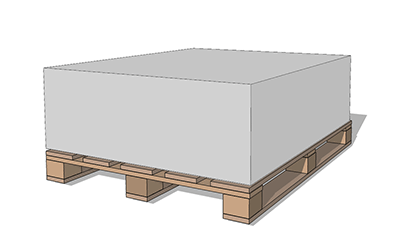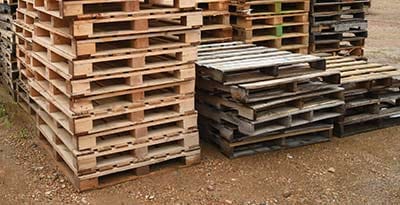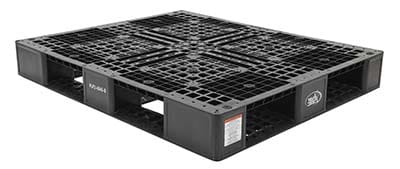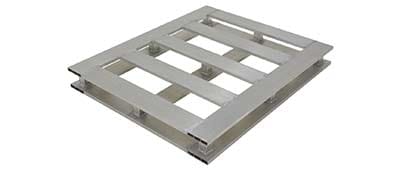What is a Pallet?
Guide to Pallet Design and Storage

A pallet, or a "skid," is a flat, portable platform used as a base to store or ship boxes or goods on. A shipping pallet's uniform design is structured to support and distribute the weight and size of the load. Once goods are stacked on a pallet, they are sometimes stabilized using strapping, stretch wrap, or other wrapping material so that the load doesn’t move or shift and is protected from fall offs.
Pallets and skids are technically different, although they are very similar. Pallets have both a top and bottom deck, where skids are a single deck loading platform and doesn't have a bottom deck.
Most importantly, pallets are designed to allow equipment such as forklifts, front loaders or pallet jacks to lift and move these supported items from place to place. This makes transporting multiple or large items a much less complicated issue.
In the logistics or material handling industries, reliable pallets are essential. They are commonly used in material handling systems such as pallet racking or carton flow rack for storage or organization, where the platform pallets with stored materials can be easily accessed and moved using fork trucks. Pallets are also commonly used in conveyor operations as well, to transport loaded pallets easily and in an organized fashion from on place to another.
It is not unusual for companies to buy used pallets, especially when it comes to wood or plastic pallets. It is also common for companies to offer both wood and plastic pallets for sale.
The most common type of pallet is made from wood, but there are other types of pallets that are better adapted for certain industries, such as metal pallets, aluminum pallets and plastic pallets. Other pallets are also made of paper or cardboard. Standards for each vary but each style has its own distinct advantage depending upon the environment that they are used in.
Buying Pallets from SJF's online store
SJF offers several different types of new pallets for sale in our online store. If you're interested in seeing what we offer, check out our plastic and aluminum pallet racks at shop.sjf.com.
Common Pallet Materials - Wood, Plastic, Steel, Aluminum

Wooden Pallets
Wood pallets are the most widespread and common type of pallet used. They offer a good combination of low cost and durability. "Stringers" or "blocks" are typically used to support the deck boards. Stringer pallets use 2-x-4 inch boards for support and block pallets use 4-x-4 inch blocks.
The majority of warehouses use wooden pallets in their daily operations. For the material handling industry, wood pallets are the standard. One distinct advantage of using wood pallets is the low cost and recyclability.
Wooden pallets are oftentimes built using common measurements for widespread use. The standard size of a wood pallet in the United States is 48" x 40". Most are made from waste lumber, which is still strong, reusable and cost-effective, but doesn't require cutting down trees to produce. The wood used to create these pallets is treated for protection against moisture and insects for safety and durability.
Typically wood pallets weigh between 25 and 75 lbs., but there are many factors in determining weight. Causes for the difference in weight include the type of boards used, the size of the pallet, and the thickness of the boards used, and more./p>
Plastic Pallets

Plastic pallets, made of recycled and recyclable molded plastic, are also a common option for storing goods. A lighter weight option, plastic pallets often are preferred over wooden pallets due to their durability. They tend to last longer than wooden pallets, are easier to clean, are FDA and USDA approved and have no fasteners or splinters to deal with. They are also typically more expensive to purchase. The weight of plastic pallets, on average, are between 15 and 30 lbs., but can weigh as much as 50 lbs. or more.
There are many different styles of plastic pallets with options ranging from weight capacity to drainage capability to complex-ability. Plastic pallets can be nestable, stackable and can be used in rack systems for easy four-way access.

Steel Pallets or Aluminum Pallets
Steel metal or aluminum pallets are the pallets the food, rubber, pharmaceutical and chemical industries commonly use. They are made of heavy duty welded metal or aluminum construction. Over time, aluminum pallets maintain their structural integrity and are free from rust, warping and rot, unlike wood pallets. Aluminum pallets are also durable, lightweight, fire-proof and recyclable.
These pallets are easy to clean and can withstand high-powered steam, pressure washers or scrubbing. They can be sterilized for markets with rigid sanitation requirements. Aluminum pallets tend to have a longer lifespan than typical wood pallets.
Steel pallets typically weigh between 50 to 80 lbs. or more. Aluminum pallets are lighter and weigh between 25 and 50 lbs. on average.
Types of Pallets
There are many different types of pallets, and each type has specific strengths for different applications. Pallets can be defined by the number of entry points for forklifts, decking styles, whether they are reversible or not, whether they have a top or bottom deck or both, whether the deck is open or solid and more.
Stringer Pallets
Stringer pallets are the most common type of pallets used in the US. These pallets use "stringers," which are typically 2" x 4" or 3" x 4" boards that are placed vertically between the top and bottom decks that support the load. Stringer pallets most often have 2-way entry points.
Block Pallets
Block pallets tend to be stronger than stringer pallets and are constructed with both perpendicular and parallel "stringers," which in this case are 4 to 12 blocks placed in key spots to support the load. They have 4-way entry points for forklifts or pallet jacks, allowing them to be accessed from any side.
One-Sided Pallets (otherwise known as single-face pallets)
Single-faced pallets have a deck on only the top side and not the bottom.
Double Sided Pallets (otherwise known as double-face pallets)
Double-face pallets have both a top and bottom deck. They can be reversible or non-reversible, which means that the reversible can be flipped without compromising integrity. They are always face up.
Solid Deck Pallets
Solid deck pallets offer 4-way entry and have a solid top deck. They are known to be strong and require less repairs than other types of pallets.

